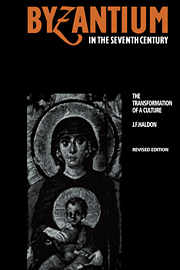Book contents
- Frontmatter
- Contents
- List of plates
- List of maps
- Preface and acknowledgements
- Preface to the revised edition
- List of abbreviations
- The sources
- Introduction
- 1 The background: state and society before Heraclius
- 2 The East Roman world c. 610–717: the politics of survival
- 3 Social relations and the economy: the cities and the land
- 4 Social relations and the economy: rural society
- 5 The state and its apparatus: fiscal administration
- 6 The state and its apparatus: military administration
- 7 Society, state and law
- 8 The imperial church and the politics of authority
- 9 Religion and belief
- 10 Forms of social and cultural organisation: infrastructures and hierarchies
- 11 Forms of representation: language, literature and the icon
- Conclusion: The transformation of a culture
- Addendum: Further observations on the question of the late ancient city
- Bibliography
- Index
6 - The state and its apparatus: military administration
Published online by Cambridge University Press: 13 November 2009
- Frontmatter
- Contents
- List of plates
- List of maps
- Preface and acknowledgements
- Preface to the revised edition
- List of abbreviations
- The sources
- Introduction
- 1 The background: state and society before Heraclius
- 2 The East Roman world c. 610–717: the politics of survival
- 3 Social relations and the economy: the cities and the land
- 4 Social relations and the economy: rural society
- 5 The state and its apparatus: fiscal administration
- 6 The state and its apparatus: military administration
- 7 Society, state and law
- 8 The imperial church and the politics of authority
- 9 Religion and belief
- 10 Forms of social and cultural organisation: infrastructures and hierarchies
- 11 Forms of representation: language, literature and the icon
- Conclusion: The transformation of a culture
- Addendum: Further observations on the question of the late ancient city
- Bibliography
- Index
Summary
THE THEMATA
As with most other aspects of the state's administrative machinery, its structures of military organisation also evolved along lines which resulted in a system of very different appearance in the eighth and ninth centuries from that which operated in the sixth and earlier seventh centuries. A number of processes, which form in practice an evolutionary whole, need to be clarified or explained. All, however, depend to a greater or lesser extent on one key problem: the origins and development of the so-called themata or military provinces and the phenomenona associated with them – the mode of recruiting, equipping and supplying the soldiers, the methods of paying them, and the fate of the civil provincial government.
The differences between the late Roman army of the sixth century and that of the Byzantine state of the ninth century are not difficult to perceive. The late Roman system was characterised by a fundamental division between the civil and military spheres of administration: civil officials had no authority over the military, and vice versa. The armies were divided into two essential groups: those of the mobile field forces, technically referred to as comitatenses (although in their turn made up of a number of distinct types of unit, differentiated originally by their posting, their mode and source of recruitment and so on), and the permanent frontier or garrison units, described and known as limitanei (although again made up from units of widely differing origins).
- Type
- Chapter
- Information
- Byzantium in the Seventh CenturyThe Transformation of a Culture, pp. 208 - 253Publisher: Cambridge University PressPrint publication year: 1990
- 1
- Cited by



